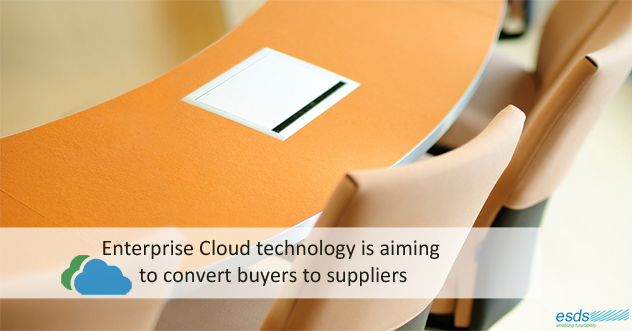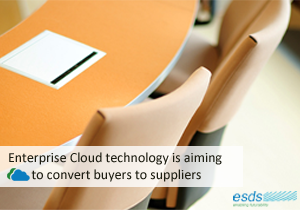Enterprise Cloud Technology is Aiming to Convert Buyers to Suppliers
 Organizations in healthcare, financial services, and other verticals are developing a new breed of clouds services for themselves to commercialize their IP and Industry expertise.
Organizations in healthcare, financial services, and other verticals are developing a new breed of clouds services for themselves to commercialize their IP and Industry expertise.
Overpowered by choices and uncertain of their precise needs, numerous enterprises IT shops battle to pick a cloud supplier. Be that as it may, as cloud implementation develops, a few organizations – particularly those in vertical markets – are debating whether to wind up one.
The rise of “industry clouds” – cloud platforms that are worked for, and regularly by, organizations within a particular vertical business sector – has accelerated, according to analysts at Directions 2016, an event facilitated by analyst firm IDC. Cloud buyers in business sectors extending from healthcare to manufacturing have turned the tables to give their own particular arrangement of vertically engaged cloud services.
“Industry cloud, at its center, is truly about the rise of purchasers getting to be suppliers,” clarified Eric Newmark, program executive industry cloud at IDC & life sciences. “It’s about organizations inside of particular commercial enterprises, in some structure or another, making esteem for different organizations in their industry.”
To be reasonable, coordinated effort between organizations inside a particular vertical business sector is just the same old thing. Industry consortiums in business sectors, for example, life sciences, for instance, have been around for a considerable time. In any case, the cloud offers a Platform for organizations to disperse and commercialize their industry expertise as an arrangement of administrations, developing and quickening this sort of cross-organization cooperation, Newmark said.
Industry cloud adoption isn’t staggering yet-IDC evaluated there are approximately 150 of them around the world today – yet they are required to develop, achieving 500 before the end of 2018 and more than 1,000 before the end of 2020.
Vertically engaged clouds are relied upon to manifest in eight markets, specifically: healthcare, financial services, life sciences, oil and gas, government, manufacturing, retail, and utilities. A standout amongst the most conspicuous cases of an industry cloud is ESDS’s eNlight Cloud, a Platform as a service.
In the meantime, banks and other financial services firms explore routes to utilize industry clouds to streamline regulatory compliance processes.
While industry clouds could be advantageous, there is the potential threat for clients to expect they can brush their hands of most, if not all, obligation with regards to consistency, said Jonathan Feldman, CIO of the city of Asheville, N.C. An organization utilizing a cloud benefit particularly intended for banking or healthcare industry, for instance, may accept consistency and security is as of now cooked in, and in this manner relax their own compliance practices.
The following are the two industrial cloud models:
Despite the fact that it’s still early days for industry cloud, there is by all accounts two driving models to assemble them.
First, as per Newmark, is the point at which an organization within a particular vertical business sector – a hospital, for instance – has some kind of IP or expertise from which they trust the business in general could advantage. They then offer that aptitude or ability as a service through the cloud – and adapt it. To abstain from putting themselves at a competitive disadvantage, most organizations offer operational capacities to boost productivity relieve from risks or diminish costs industry wide.
The second industry cloud model includes various organizations within an industry mutually making a cloud platform or service. These tend to be information driven clouds, Newmark said. For instance, organizations could pool some of their information together in the cloud, and afterward, have it mined and broke down, either all together or by the third party, to increase more extensive and more exact knowledge into industry-wide patterns.
In either model, it’s fitting for organizations constructing an industry cloud to join forces with a cloud service provider, and even host their cloud on the foundation from pioneers, for example, Microsoft Azure, Google, or Amazon Web Services, as per Newmark.
“It’s exceptionally troublesome for end-client organizations all alone to make effective, adaptable and flexible cloud-construct platform services without pioneers in light of the IT side,” he said.
Feldman, as far as concerns him, said It’d be a great deal all the more ready to utilize an industry cloud in the event that it had the heaviness of a built up cloud supplier behind it.
“I believe that would be more valid,” he said.
Notwithstanding collaborating with a cloud merchant, associations constructing an industry cloud additionally should guarantee both their IT group and line-of-business divisions are included. While it’s not generally simple to separate the hindrances between those two gatherings, it’s definitely justified even despite the exertion, Newmark said. Indeed, making an industry cloud can even obscure the line between the business and IT.
“One of the primary things [CIOs] battle with is, ‘the manner by which do I change this discernment in my association that IT is a cost focus, to something that is going to drive top-line income and development?’,” he said. “The business cloud opportunity, which popularizes a great deal of what IT does, adjusts pretty splendidly to that.”
- Signs of Cyber Attack and How to Respond to them? - March 25, 2019
- The Menace of Clickjacking - March 20, 2019
- How to choose a DDoS solution fit for your business? - March 1, 2019

